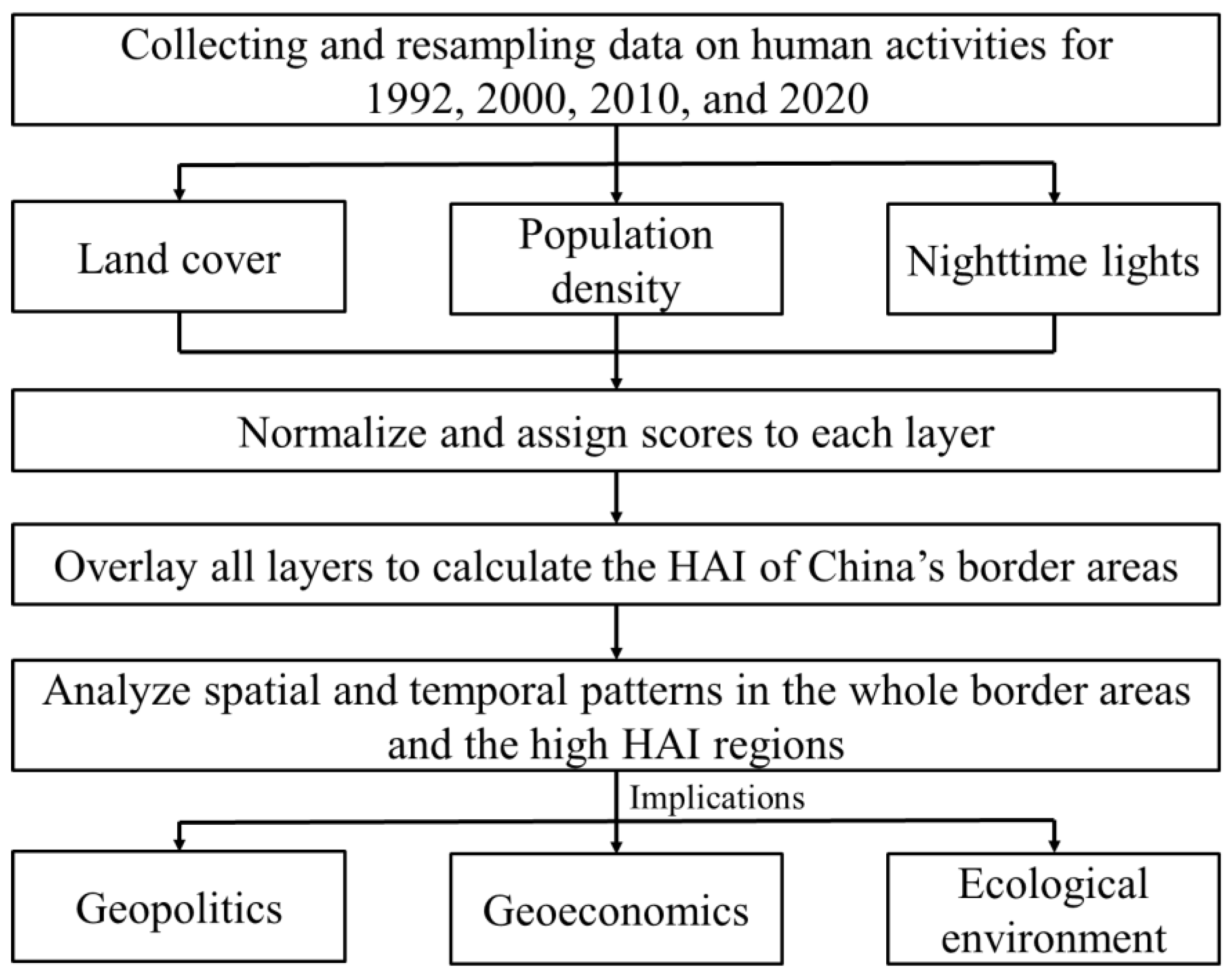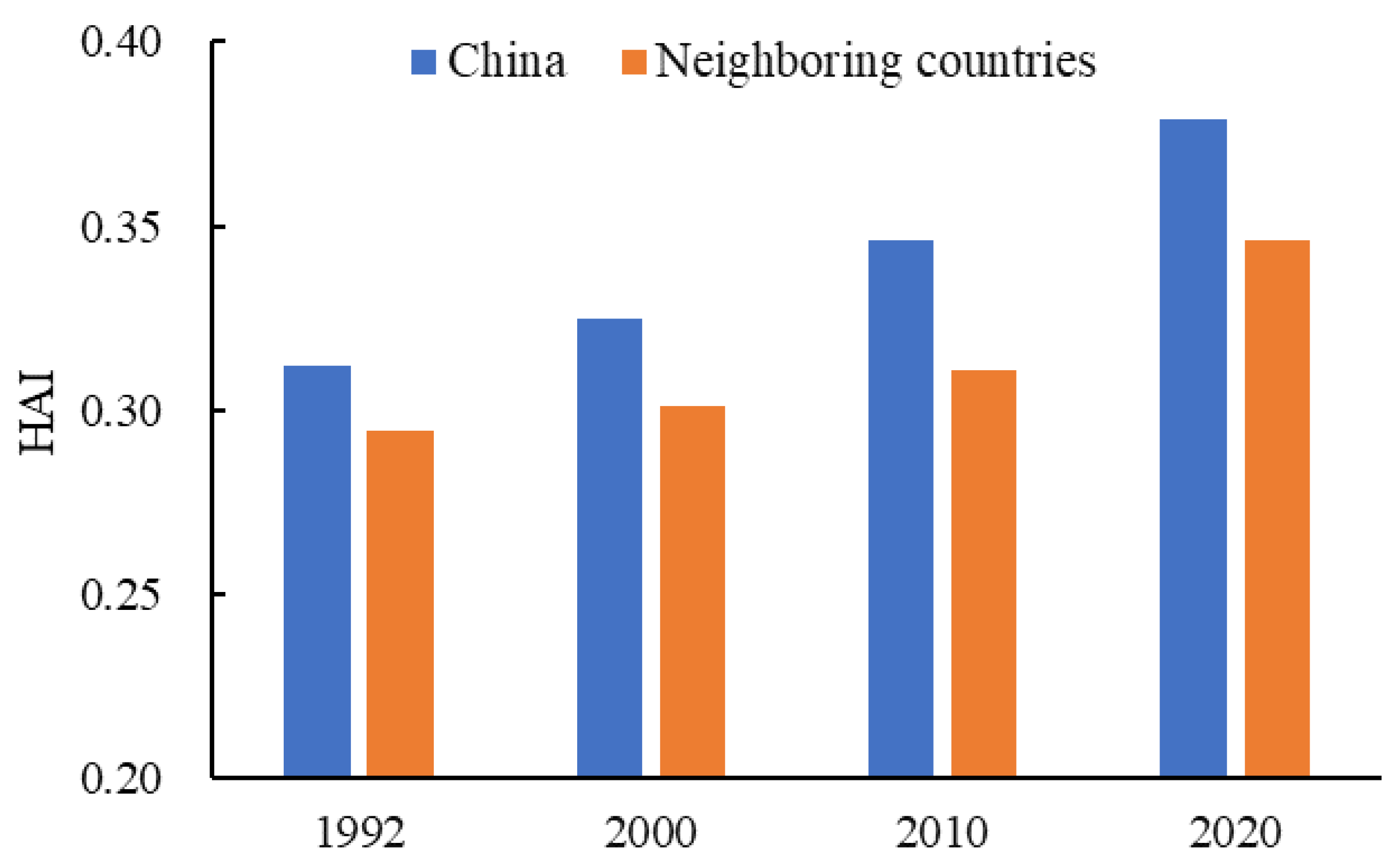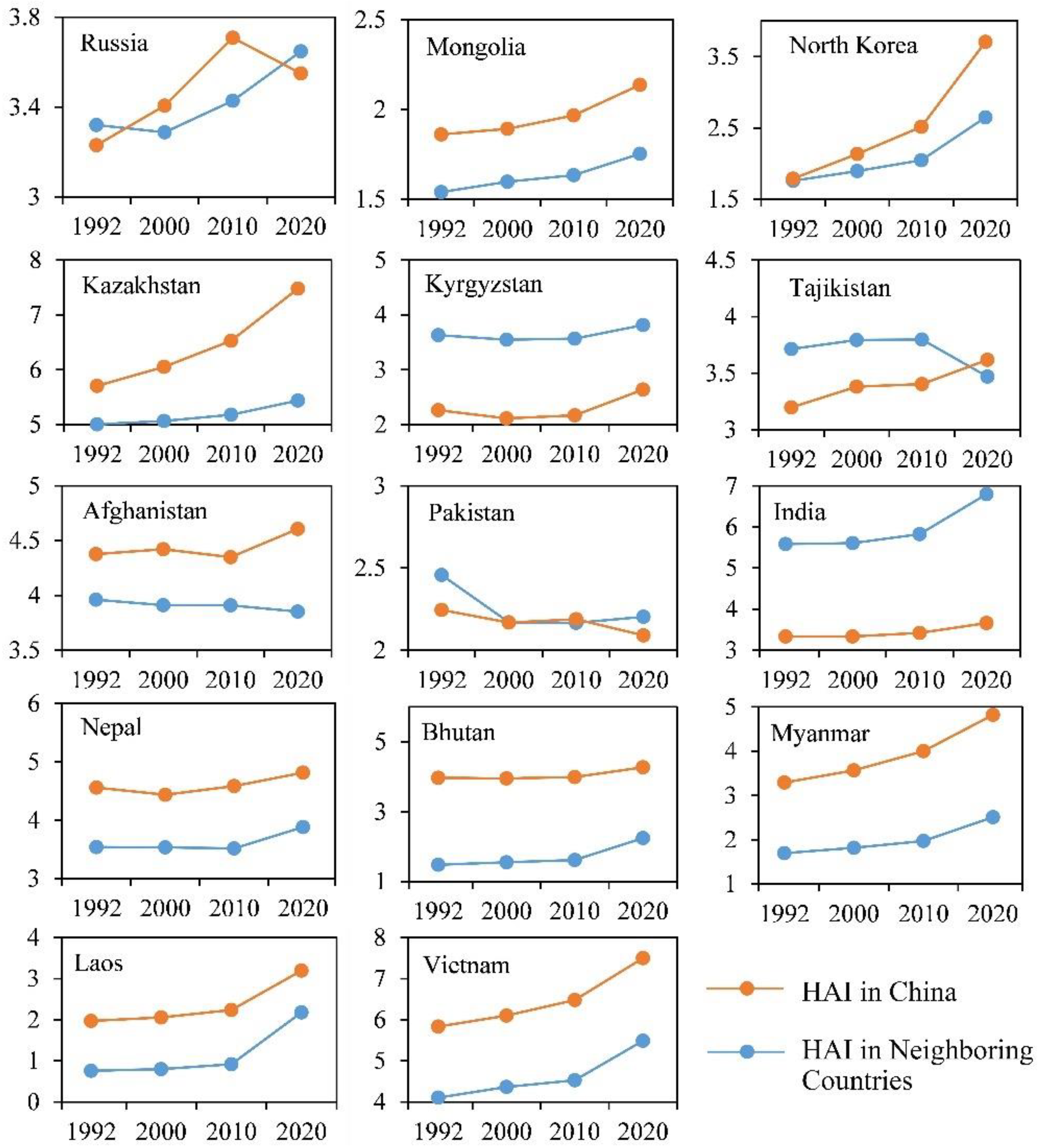Human Activity Intensity and Its Spatial-Temporal Evolution in China’s Border Areas
Abstract
:1. Introduction
2. Data and Methodology
2.1. Study Area
2.2. Data Sources and Preprocessing
2.2.1. Land Cover
2.2.2. Population Density
2.2.3. Nighttime Light
2.3. Methodology
3. Results
3.1. Evolution of HAI in the Whole Border Area
3.2. Interstate Comparison along the Boundary
3.3. Selected Regional Analysis
3.4. Hotspot Analysis
4. Discussion
4.1. Comparisons with Previous Studies
4.2. Geopolitical and Geoeconomic Implications of HAI Changes in Border Areas
4.3. Implications of the HAI for Ecosystem Services and Biodiversity
4.4. Research Deficiencies and Prospects
5. Conclusions
Author Contributions
Funding
Institutional Review Board Statement
Informed Consent Statement
Data Availability Statement
Acknowledgments
Conflicts of Interest
References
- Crutzen, P.J. Geology of mankind. Nature 2002, 415, 23. [Google Scholar] [CrossRef] [PubMed]
- Masson-Delmotte, V.; Zhai, P.; Pirani, A.; Connors, S.L.; Péan, C.; Berger, S.; Caud, N.; Chen, Y.; Goldfarb, L.; Gomis, M.I.; et al. Climate Change 2021: The Physical Science Basis; IPCC: Geneva, Switzerland, 2021. [Google Scholar]
- Honghu Meng, X.G.; Song, Y.; Cao, G.; Li, J. Biodiversity arks in the Anthropocene. Reg. Sustain. 2021, 2, 109–115. [Google Scholar] [CrossRef]
- Steffen, W.; Richardson, K.; Rockström, J.; Cornell, S.E.; Fetzer, I.; Bennett, E.M.; Biggs, R.; Carpenter, S.R.; De Vries, W.; De Wit, C.A. Planetary boundaries: Guiding human development on a changing planet. Science 2015, 347, 1259855. [Google Scholar] [CrossRef] [PubMed] [Green Version]
- Cheng, Y.; Liu, H.M.; Wang, S.B.; Cui, X.G.; Li, Q.R. Global action on SDGs: Policy review and outlook in a post-pandemic era. Sustainability 2021, 13, 6461. [Google Scholar] [CrossRef]
- Williams, B.A.; Venter, O.; Allan, J.R.; Atkinson, S.C.; Rehbein, J.A.; Ward, M.; Di Marco, M.; Grantham, H.S.; Ervin, J.; Goetz, S.J.; et al. Change in terrestrial human footprint drives continued loss of intact ecosystems. One Earth 2020, 3, 371–382. [Google Scholar] [CrossRef]
- Josa, I.; Aguado, A. Infrastructures and society: From a literature review to a conceptual framework. J. Clean. Prod. 2019, 238, 117741. [Google Scholar] [CrossRef]
- Nassauer, J.I.; Raskin, J. Urban vacancy and land use legacies: A frontier for urban ecological research, design, and planning. Landsc. Urban Plan. 2014, 125, 245–253. [Google Scholar] [CrossRef]
- Xiao, C.; Li, P.; Feng, Z.; Zheng, F. Global border watch: From land use change to joint action. Int. J. Appl. Earth Obs. Geoinf. 2021, 103, 102494. [Google Scholar] [CrossRef]
- Studies of Endangered Animals on Border of China and Vietnam Stress Need for Transboundary Conservation: As Climate Change Forces Species to Migrate across Borders, Scientists Recommend Coordinated Approaches to Prevent Biodiversity Loss. Available online: www.sciencedaily.com/releases/2022/03/220322150915.htm (accessed on 12 May 2022).
- Norman, L.M.; Feller, M.; Guertin, D.P. Forecasting urban growth across the United States-Mexico border. Comput. Environ. Urban Syst. 2009, 33, 150–159. [Google Scholar] [CrossRef]
- Mu, H.W.; Li, X.C.; Wen, Y.A.; Huang, J.X.; Du, P.J.; Su, W.; Miao, S.X.; Geng, M.Q. A global record of annual terrestrial human footprint dataset from 2000 to 2018. Sci. Data 2022, 9, 176. [Google Scholar] [CrossRef]
- Bowler, D.E.; Bjorkman, A.D.; Dornelas, M.; Myers-Smith, I.H.; Navarro, L.M.; Niamir, A.; Supp, S.R.; Waldock, C.; Winter, M.; Vellend, M.; et al. Mapping human pressures on biodiversity across the planet uncovers anthropogenic threat complexes. People Nat. 2020, 2, 380–394. [Google Scholar] [CrossRef] [Green Version]
- Mammides, C. A global assessment of the human pressure on the world’s lakes. Glob. Environ. Chang. 2020, 63, 102084. [Google Scholar] [CrossRef]
- Vanham, D.; Leip, A.; Galli, A.; Kastner, T.; Bruckner, M.; Uwizeye, A.; van Dijk, K.; Ercin, E.; Dalin, C.; Brandão, M.; et al. Environmental footprint family to address local to planetary sustainability and deliver on the SDGs. Sci. Total Environ. 2019, 693, 133642. [Google Scholar] [CrossRef] [PubMed]
- Martinez-Ramos, M.; Ortiz-Rodriguez, I.A.; Pinero, D.; Dirzo, R.; Sarukhan, J. Anthropogenic disturbances jeopardize biodiversity conservation within tropical rainforest reserves. Proc. Natl. Acad. Sci. USA 2016, 113, 5323–5328. [Google Scholar] [CrossRef] [PubMed] [Green Version]
- Danneyrolles, V.; Dupuis, S.; Fortin, G.; Leroyer, M.; de Romer, A.; Terrail, R.; Vellend, M.; Boucher, Y.; Laflamme, J.; Bergeron, Y.; et al. Stronger influence of anthropogenic disturbance than climate change on century-scale compositional changes in northern forests. Nat. Commun. 2019, 10, 1265. [Google Scholar] [CrossRef] [PubMed]
- Sanderson, E.W.; Jaiteh, M.; Levy, M.A.; Redford, K.H.; Wannebo, A.V.; Woolmer, G. The human footprint and the last of the wild. Bioscience 2002, 52, 891–904. [Google Scholar] [CrossRef]
- Venter, O.; Sanderson, E.W.; Magrach, A.; Allan, J.R.; Beher, J.; Jones, K.R.; Possingham, H.P.; Laurance, W.F.; Wood, P.; Fekete, B.M.; et al. Sixteen years of change in the global terrestrial human footprint and implications for biodiversity conservation. Nat. Commun. 2016, 7, 12558. [Google Scholar] [CrossRef] [Green Version]
- Li, S.; Zhang, Y.; Wang, Z.; Li, L. Mapping human influence intensity in the Tibetan Plateau for conservation of ecological service functions. Ecosyst. Serv. 2018, 30, 276–286. [Google Scholar] [CrossRef]
- Antaya, A.M. Effects of Human Activity on the Distribution of Desert Bighorn Sheep Along the Border in Southwestern Arizona and Northern Sonora. Master’s Thesis, The University of Arizona, Tucson, AZ, USA, 2018. [Google Scholar]
- Rutt, C.D.; Coleman, K.J. The impact of the built environment on walking as a leisure-time activity along the U.S./Mexico border. J. Phys. Act. Health 2005, 2, 257–271. [Google Scholar] [CrossRef]
- McCallum, J. National borders matter: Canada-US regional trade patterns. Am. Econ. Rev. 1995, 85, 615–623. [Google Scholar]
- Ziegler, A.D.; Fox, J.M.; Xu, J. The rubber juggernaut. Science 2009, 324, 1024–1025. [Google Scholar] [CrossRef] [PubMed]
- Payan, T.; Cruz, P.L. Binational Commons: Institutional Development and Governance on the U.S.—Mexico Border; University of Arizona Press: Tucson, AZ, USA, 2020. [Google Scholar]
- Mueller, M.F.; Yoon, J.; Gorelick, S.M.; Avisse, N.; Tilmant, A. Impact of the Syrian refugee crisis on land use and transboundary freshwater resources. Proc. Natl. Acad. Sci. USA 2016, 113, 14932–14937. [Google Scholar] [CrossRef] [PubMed] [Green Version]
- Dai, C.W. China’s strategy for Sino-Indian boundary disputes, 1950–1962. Asian Perspect. 2019, 43, 435–457. [Google Scholar] [CrossRef]
- Murton, G.; Lord, A. Trans-Himalayan power corridors: Infrastructural politics and China’s Belt and Road Initiative in Nepal. Political Geogr. 2020, 77, 102100. [Google Scholar] [CrossRef]
- Holslag, J. The persistent military security dilemma between China and India. J. Strateg. Stud. 2009, 32, 811–840. [Google Scholar] [CrossRef]
- Maxwell, N. Forty years of folly: What caused the Sino-Indian border war and why the dispute is unresolved. Crit. Asian Stud. 2003, 35, 99–112. [Google Scholar] [CrossRef]
- Liu, H.M.; Fang, C.L.; Miao, Y.; Ma, H.T.; Zhang, Q.; Zhou, Q. Spatio-temporal evolution of population and urbanization in the countries along the Belt and Road 1950–2050. J. Geogr. Sci. 2018, 28, 919–936. [Google Scholar] [CrossRef] [Green Version]
- Jiang, H. Cooperation, land use, and the environment in Uxin Ju: The changing landscape of a Mongolian-Chinese borderland in China. Ann. Assoc. Am. Geogr. 2004, 94, 117–139. [Google Scholar] [CrossRef]
- Sturgeon, J.C. Border Landscapes: The Politics of Akha Land Use in China and Thailand; University of Washington Press: Seattle, WA, USA, 2005. [Google Scholar]
- Murton, G. Making mountain places into state spaces: Infrastructure, consumption, and territorial practice in a Himalayan borderland. Ann. Am. Assoc. Geogr. 2017, 107, 536–545. [Google Scholar] [CrossRef]
- Gu, X.S.; Womack, B. Border cooperation between China and Vietnam in the 1990s. Asian Surv. 2000, 40, 1042–1058. [Google Scholar]
- Schoenberger, L.; Turner, S. Negotiating remote borderland access: Small-scale trade on the Vietnam-China border. Dev. Change 2008, 39, 667–696. [Google Scholar] [CrossRef]
- Ge, Y.; He, Y.; Jiang, Y.; Yin, X. Border trade and regional integration. Rev. Dev. Econ. 2014, 18, 300–312. [Google Scholar] [CrossRef]
- Alexseev, M.A. Socioeconomic and security implications of Chinese migration in the Russian Far East. Post-Sov. Geogr. Econ. 2001, 42, 122–141. [Google Scholar] [CrossRef]
- Su, X.; Cai, X. Space of compromise: Border control and the limited inclusion of burmese migrants in China. Ann. Am. Assoc. Geogr. 2020, 110, 847–863. [Google Scholar] [CrossRef]
- Wang, X.; Ma, W.; Hua, T.; Li, D. Variation in vegetation greenness along China’s land border. Sci. China-Earth Sci. 2017, 60, 2025–2032. [Google Scholar] [CrossRef]
- Liu, X.; Jiang, L.; Feng, Z.; Li, P. Rubber plantation expansion related land use change along the Laos-China border region. Sustainability 2016, 8, 1011. [Google Scholar] [CrossRef] [Green Version]
- Song, T.; Chahine, T.; Sun, M. Ruili, China: The China-Myanmar nexus hub at the crossroads. Cities 2020, 104, 102766. [Google Scholar] [CrossRef]
- Lechevalier, A.; Wielgohs, J. Borders and Border Regions in Europe: Changes, Challenges and Chances; Transcript Verlag: Bielefeld, Germany, 2013. [Google Scholar]
- Xu, Y.; Xu, X.; Tang, Q. Human activity intensity of land surface: Concept, methods and application in China. J. Geogr. Sci. 2016, 26, 1349–1361. [Google Scholar] [CrossRef]
- Li, Y.; Yin, B.; Li, Y. Early warning signals for landscape connectivity and resilient conservation solutions. Land Degrad. Dev. 2019, 30, 73–83. [Google Scholar] [CrossRef] [Green Version]
- Zhao, G.; Liu, J.; Kuang, W.; Ouyang, Z.; Xie, Z. Disturbance impacts of land use change on biodiversity conservation priority areas across China: 1990–2010. J. Geogr. Sci. 2015, 25, 515–529. [Google Scholar] [CrossRef] [Green Version]
- Wang, Y.; Liu, Z.; He, C.; Xia, P.; Liu, Z.; Liu, H. Quantifying urbanization levels on the Tibetan Plateau with high-resolution nighttime light data. Geogr. Sustain. 2020, 1, 233–244. [Google Scholar] [CrossRef]
- Wu, R.; Yang, D.; Dong, J.; Zhang, L.; Xia, F. Regional Inequality in China Based on NPP-VIIRS Night-Time Light Imagery. Remote Sens. 2018, 10, 240. [Google Scholar] [CrossRef] [Green Version]
- Mellander, C.; Lobo, J.; Stolarick, K.; Matheson, Z. Night-time light data: A good proxy measure for economic activity? PLoS ONE 2015, 10, e0139779. [Google Scholar] [CrossRef] [PubMed] [Green Version]
- Singhal, A.; Sahu, S.; Chattopadhyay, S.; Mukherjee, A.; Bhanja, S.N. Using night time lights to find regional inequality in India and its relationship with economic development. PLoS ONE 2020, 15, e0241907. [Google Scholar] [CrossRef]
- Li, X.; Zhou, Y.; Zhao, M.; Zhao, X. A harmonized global nighttime light dataset 1992–2018. Sci. Data 2020, 7, 168. [Google Scholar] [CrossRef]
- Notteboom, T.; Pallis, A.; Rodrigue, J.-P. Port Economics, Management and Policy; Routledge: New York, NY, USA, 2022; p. 690. [Google Scholar]
- Okunev, I.Y.; Tislenko, M.I. Geopolitical positioning of twin cities: A case study of Narva/Ivangorod, Valga/Valka, and Blagoveshchensk/Heihe. Teor. Praksa 2017, 54, 592–605. [Google Scholar]
- Mikhailova, E.V. Appearance and Appliance of the Twin-Cities Concept on the Russian-Chinese Border. In Proceedings of the ISPRS/IGU/ICA Joint International Workshop on Borderlands Modelling and Understanding for Global Sustainability, Beijing, China, 5–6 December 2013; pp. 105–110. [Google Scholar]
- You, Z.; Feng, Z.; Lei, Y.; Yang, Y.; Li, F. Regional features and national differences in population distribution in China’s border regions (2000–2015). Sustainability 2017, 9, 336. [Google Scholar] [CrossRef] [Green Version]
- Huang, D.; Lang, Y.; Liu, T. Evolving population distribution in China’s border regions: Spatial differences, driving forces and policy implications. PLoS ONE 2020, 15, e0240592. [Google Scholar] [CrossRef]
- Stokes, E.C.; Seto, K.C. Characterizing urban infrastructural transitions for the Sustainable Development Goals using multi-temporal land, population, and nighttime light data. Remote Sens. Environ. 2019, 234, 111430. [Google Scholar] [CrossRef]
- Duoping, Z.; Gennian, S.; Jianjun, S. Research on tourist flow evolution trends and motivation analysis of China’s border tourism: A comparative case study of Xinjiang, Inner Mongolia and Yunnan. Hum. Geogr. 2012, 27, 134–139. [Google Scholar] [CrossRef]
- Song, T.; Cheng, Y.; Liu, W.; Liu, H. Spatial difference and mechanisms of influence of geo-economy in the border areas of China. J. Geogr. Sci. 2017, 27, 1463–1480. [Google Scholar] [CrossRef] [Green Version]
- Davis, A.E.; Gamble, R.; Roche, G.; Gawne, L. International relations and the Himalaya: Connecting ecologies, cultures and geopolitics. Aust. J. Int. Aff. 2021, 75, 15–35. [Google Scholar] [CrossRef]
- Fang, C.; Liu, H.; Wang, S. The coupling curve between urbanization and the eco-environment: China’s urban agglomeration as a case study. Ecol. Indic. 2021, 130, 108107. [Google Scholar] [CrossRef]
- Liu, H.; Cui, W.; Zhang, M. Exploring the causal relationship between urbanization and air pollution: Evidence from China. Sustain. Cities Soc. 2022, 80, 103783. [Google Scholar] [CrossRef]
- Shen, W.; Zhang, J.; Zhou, X.; Li, S.; Geng, X. How to Perceive the Trade-Off of Economic and Ecological Intensity of Land Use in a City? A Functional Zones-Based Case Study of Tangshan, China. Land 2021, 10, 551. [Google Scholar] [CrossRef]
- Ji, G.; Song, H.; Wei, H.; Wu, L. Attribution Analysis of Climate and Anthropic Factors on Runoff and Vegetation Changes in the Source Area of the Yangtze River from 1982 to 2016. Land 2021, 10, 612. [Google Scholar] [CrossRef]
- Mi, X.C.; Feng, G.; Hu, Y.B.; Zhang, J.; Chen, L.; Corlett, R.T.; Hughes, A.C.; Pimm, S.; Schmid, B.; Shi, S.H.; et al. The global significance of biodiversity science in China: An overview. Natl. Sci. Rev. 2021, 8, nwab032. [Google Scholar] [CrossRef]
- Tang, D.M.; Fan, H.; Yang, K.; Zhang, Y. Mapping forest disturbance across the China-Laos border using annual Landsat time series. Int. J. Remote Sens. 2019, 40, 2895–2915. [Google Scholar] [CrossRef]
- Wang, L.; Yang, B.; Bai, Y.; Lu, X.Q.; Corlett, R.T.; Tan, Y.H.; Chen, X.Y.; Zhu, J.G.; Liu, Y.; Quan, R.C. Conservation planning on China’s borders with Myanmar, Laos, and Vietnam. Conserv. Biol. 2021, 35, 1797–1808. [Google Scholar] [CrossRef]
- Liu, H.M.; Fang, C.L.; Fang, K. Coupled human and natural cube: A novel framework for analyzing the multiple interactions between humans and nature. J. Geogr. Sci. 2020, 30, 355–377. [Google Scholar] [CrossRef]
- Kang, S.C.; Zhang, Q.G.; Qian, Y.; Ji, Z.M.; Li, C.L.; Cong, Z.Y.; Zhang, Y.L.; Guo, J.M.; Du, W.T.; Huang, J.; et al. Linking atmospheric pollution to cryospheric change in the Third Pole region: Current progress and future prospects. Natl. Sci. Rev. 2019, 6, 796–809. [Google Scholar] [CrossRef] [PubMed]
- Hull, V.; Liu, J. Telecoupling: A new frontier for global sustainability. Ecol. Soc. 2018, 23, 41. [Google Scholar] [CrossRef]







| Land Type | Description | Sub-HAI Score |
|---|---|---|
| Settlement | Urban areas | 10 |
| Agricultural land | Cropland, rainfed | 6 |
| Cropland, irrigated or post-flooding | 4 | |
| Cropland, rainfed, herbaceous cover | 3 | |
| Cropland, rainfed, tree, or shrub cover | 3 | |
| Mosaic cropland (>50%)/natural vegetation (tree, shrub, herbaceous cover) (<50%) | 3 | |
| Grassland | Grassland | 2 |
| Mosaic herbaceous cover (>50%)/tree and shrub (<50%) | 2 | |
| Water | Water bodies | 1 |
| Others | Others | 0 |
| HAI Types | HAI Ranging | Description |
|---|---|---|
| High | >4 | Area with dense population, relatively developed economy, and urban landscape. |
| Relatively high | 3–4 | Distributed in suburban areas, scattered towns, rural areas, industrial and mining areas. |
| Relatively low | 1–3 | There are traces of human cultivation, mainly farmland and grassland. |
| Low | 0.1–1 | It is basically the same as the natural coverage of forests, lakes, alpine meadows, etc., but there are occasional human activities. |
| Very Low | <0.1 | Consistent with exposed areas such as plateaus and deserts, they are extremely difficult to reach or unsuitable areas for human habitation. |
Publisher’s Note: MDPI stays neutral with regard to jurisdictional claims in published maps and institutional affiliations. |
© 2022 by the authors. Licensee MDPI, Basel, Switzerland. This article is an open access article distributed under the terms and conditions of the Creative Commons Attribution (CC BY) license (https://creativecommons.org/licenses/by/4.0/).
Share and Cite
Cheng, Y.; Liu, H.; Chen, D.; Liu, H. Human Activity Intensity and Its Spatial-Temporal Evolution in China’s Border Areas. Land 2022, 11, 1089. https://doi.org/10.3390/land11071089
Cheng Y, Liu H, Chen D, Liu H. Human Activity Intensity and Its Spatial-Temporal Evolution in China’s Border Areas. Land. 2022; 11(7):1089. https://doi.org/10.3390/land11071089
Chicago/Turabian StyleCheng, Yi, Hui Liu, Dongmei Chen, and Haimeng Liu. 2022. "Human Activity Intensity and Its Spatial-Temporal Evolution in China’s Border Areas" Land 11, no. 7: 1089. https://doi.org/10.3390/land11071089
APA StyleCheng, Y., Liu, H., Chen, D., & Liu, H. (2022). Human Activity Intensity and Its Spatial-Temporal Evolution in China’s Border Areas. Land, 11(7), 1089. https://doi.org/10.3390/land11071089








